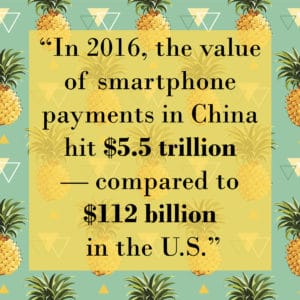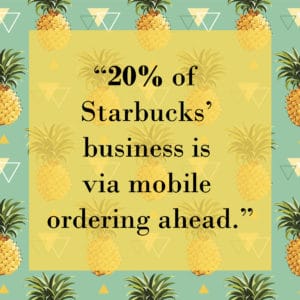Mobile pay is one of those topics that never seems to go away these days. Yet despite its prevalence in the payments, tech, and retail spheres, mobile pay in the US is hardly performing the way experts expected. Unlike in China, where mobile pay has all but eliminated both cash and cards, in America mobile pay adoption is moving at a glacial pace. A recent PYMTs article stated:
“In 2016, the value of smartphone payments in China hit $5.5 trillion — compared to the $112 billion market in the U.S., according to IR Search. That roughly 50-fold difference in size denotes that in the U.S.”
In 2018, many companies—banking, tech, and retail alike—are trying to look beyond the conventional “Pays” in the hopes of bypassing the trend to get ahead of the proverbial next big thing.

Breaking out of the POS
Traditionally, mobile pay is thought of in terms of NFC terminals at physical POS setups. And while this form of adoption has been successful in other nations, it’s almost non-existent in the US. Among the top mobile Pays, the highest consumer adoption rate comes from Walmart Pay, with 5.95% of its consumer base currently using the app. Apple Pay follows close behind with a 5.7% usage rate. Samsung Pay trails in third at 3.03% with Android Pay at the lowest usage rate at 1.8%.

This sluggish adoption of Pays has many looking to other mobile options. For retailers, especially QSR’s (quick service restaurant), order-ahead presents a much more enticing option. Starbucks, who led the industry in order-ahead creation, now sees 20% of its business via mobile ordering ahead. And while the Pays cannot seem to break a 10% adoption since Apple Pays launch in 2014, Starbucks 20% came in just three years, with no sign of slowing.
As a result, other QSR’s are taking similar approaches. Dunkin’ Donuts announced it is testing an entire new ordering experience with a test store in Massachusetts which will eventually roll out to all locations once they’ve perfected the experience. This test store features kiosks for speedier ordering in-store, designated mobile-pickup areas, and a separate drive-through for individuals ordering ahead via the DD Perks app.
Thinking Outside the Pays

This shift seen in QSR’s translates into a number of other industries as well. Consumers increasingly want to bypass the traditional bottlenecks of shopping. Rather than focusing on creating POS systems capable of taking a variety of Pays, many companies are thinking on a larger scale more inline with that of Amazon.
Consumers want connected commerce rather than new gadgets at the checkout. This can take on any number of definitions depending on the industry. Walmart has seen a great deal of success with their order-ahead offerings, allowing consumers to shop online then pick up curbside.
Similarly, Kroger is quietly ramping up its technology to rival the Amazon experience. The grocery heavyweight has shifted its focus to create a more omnichannel experience. They are also working towards the death of traditional POS rather than fighting it, by testing out “Scan, Bag, Go” at several Cincinnati locations.
Bottom Line

In China, the shift to mobile pay was significant: the nation went from cash-first to mobile-first, bypassing cards entirely. In America, mobile adoption has been an entirely different story. The Pays haven’t caught on for the simple fact that they bear limited difference from the plastic cards we’re already familiar with.
However, as we look ahead at the state of mobile pay in 2018, it’s clear that America may follow a similar leapfrog trajectory. As merchants continue to shift their focus towards creating fast, seamless consumer experiences, the concept of POS systems will fundamentally change. The Pays, as we’ve come to think of them, will likely become obsolete as the way we shop and pay changes across all industries.

